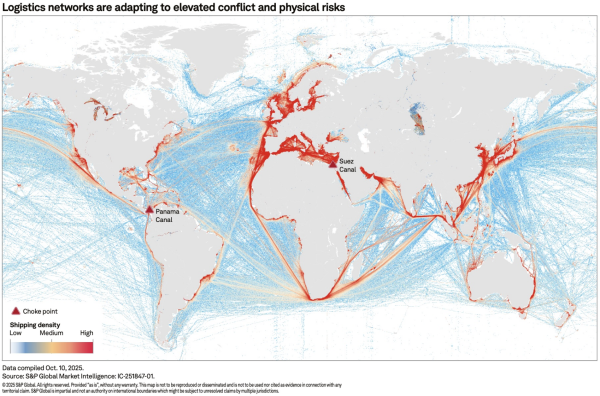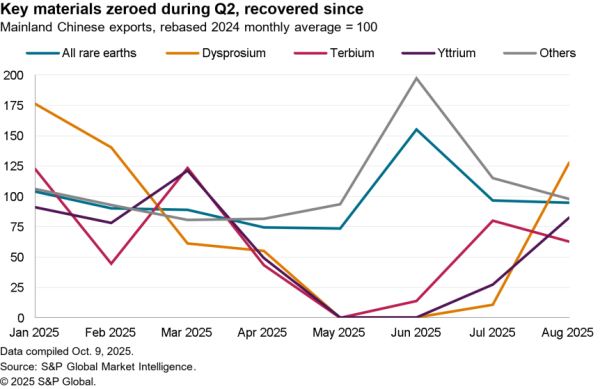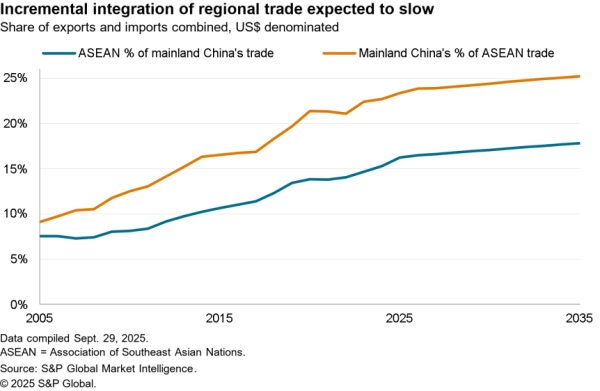This report is based on a fireside chat meeting between Josh Green, Panjiva’s co-founder, and Congresswoman Stephanie Green held on Nov. 27 in New York looking at current and future U.S. trade policy. Text is based on commentary from Mr. Green while quotes from Congresswoman Murphy are shown separately. A transcript is available on request.
Setting the scene – the U.S. trade deficit
Starting with first principles the trade deficit is the primary way the administration of President Donald Trump keeps track of the state of America’s international trade position. The trade deficit has in fact been growing rather than shrinking, as shown in the chart below. In fact the number of shipments in October hit the highest since we’ve been tracking the data – and that’s in the midst of a trade war.
That growth is testament both to the resilience of the American consumer and their spending in the midst of tariffs. Second it shows a rush on the part of business to get ahead of tariffs being applied to Chinese exports. The trade deficit with China (the blue line below) has been steadily increasing.
“We’re talking about the specific trade dispute that’s going on right now but it has broader long term implications for tech standards. We’ve owned those standards that the world build to and as a result it’s created a platform for innovation within our economies that’s also import for national security.”
(Rep. Stephanie Murphy)

Source: Panjiva
USMCA – Signature accomplishment, ratification needed
President Trump’s signature accomplishment in the first two years of the administration has been the renegotiation of NAFTA as the USMCA. NAFTA certainly needed to be updated – the internet was not a thing when it was negotiated.
Autos also received a lot of attention – as the chart below shows vehicles are the biggest category when it comes to trade between the U.S., Canada and Mexico. That sector will continue to get a lot of attention in areas such as the General Motors announcement outlined in Panjiva research of Nov. 27.
The next stage is for USMCA to be reviewed by Congress for potential passage in 2019.
“Trade has to be the place that Democrats and Republicans work together. I’ve been a little dismayed that in the Republican-held Congress there has been so little oversight on the administration’s trade moves…Constitutionally the power to regulate trade with foreign countries sits with Congress but over time we have metered away some of our power.”
(Rep. Stephanie Murphy)

Source: Panjiva
Winning the trade war, or not
Coming back to the China-U.S. trade war there has been a pretty significant downturn in American exports to China of products that have been afflicted by tariffs. The blue bar in the chart below shows what has happened to products that were affected by tariffs in July while the orange shows the August round. You can see the rush to get ahead of tariffs and subsequent slump in shipments.
One interpretation is that China, but the virtue of the way the economy is run, can actually directly affect buying decisions that result in numbers like these.

Source: Panjiva
The challenge for executives is to figure out what to make of the tariff what and what is going on as a result of the different trade battles. The chart below shows auto companies that import to the U.S. from China and what they are doing. Some are decreasing their imports as they don’t know what to make of the economic landscape. Others are increasing to hedge against the risks of short-term changes. However, it has become very hard for executives to make decisions even in the short-term.
“I represent districts in Orlando and central Florida and I met with a constituent of mine who’s built a business of aftermarket auto components and he was struggling to figure out how he was going to pay the tariff. Tariffs on a big purchase has a significant impact on his cash flow. He knows he how to handle it for a certain period of time, but how long is this going to last? When I hear from folks like him and others in my community there’s more of a sense of desperation.”
(Rep. Stephanie Murphy)

Source: Panjiva
The trade war isn’t just about trade
The defining characteristic of the economic landscape right now is uncertainty. If you look further ahead there’s a clear trend where China is catching up with the U.S. as a large importer. Historically the U.S. has been the largest buyer of products globally, but what the chart below shows is that we are arriving at a trade singularity within the next five years when China will become the largest.
“I think that it’s imperative that we have leadership in global trade. We have spent decades making sure that products are safe and we have set the standards for the world because we were the leading consumer in the world and people manufacture to our standards. To think that we are going to cede that ground and be subject to whatever standards are good enough for China should terrify everybody in the United States right now.”
“I think (tackling China) in a multilateral way would have been a better approach. Tariffs might have been one of the tools in the toolbox for applying pressure to China. The European Union cares about intellectual property as much as we do. Had we been able to apply pressure from a lot of different angles we might have a better result than these go-it-alone trade wars.”
“I hope (there are win-win outcomes) because conflict between the two largest economies in the world is not good for anyone … I have to believe there’s an off-ramp here. For us to de-escalate the situation and get to a more reasonable negotiating position.”
(Rep. Stephanie Murphy)

Source: Panjiva




